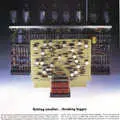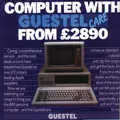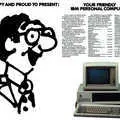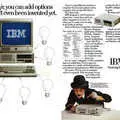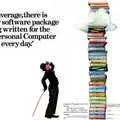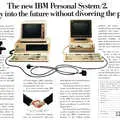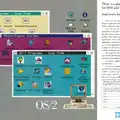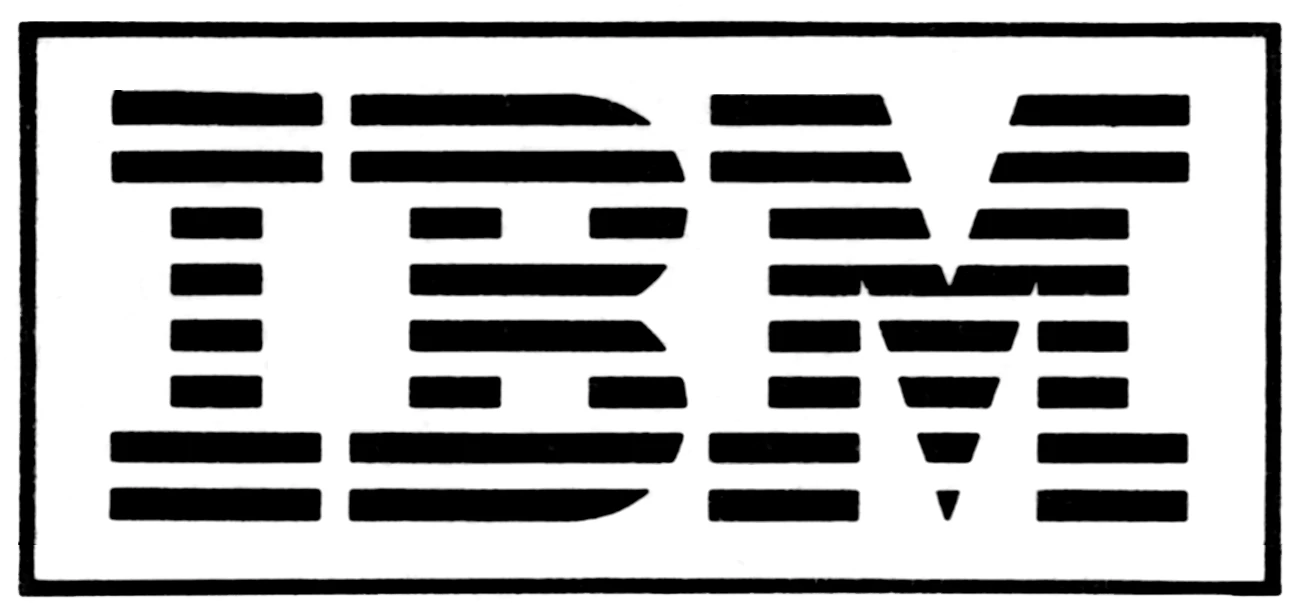
IBM Advert - November 1987
From Practical Computing
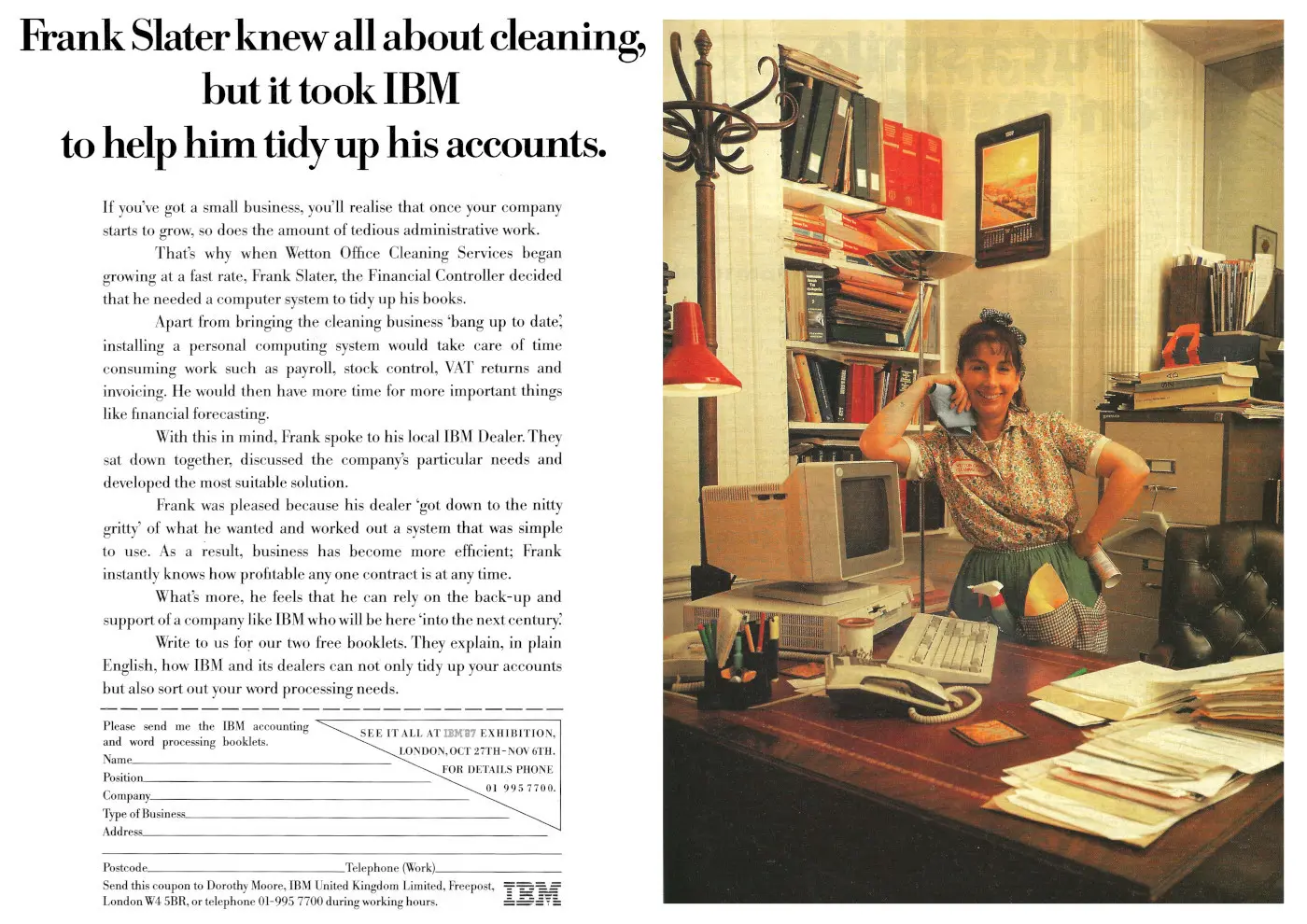
Frank Slater knew all about cleaning, but it took IBM to help him tidy up his accounts
Here's another advert for IBM's PS/2, or rather it isn't as such as whilst it features a PS/2 in the office photo, it is - in common with a lot of IBM's adverts - more about the company itself and how it will be around 'into the next century'.
The PS/2 had been launched in April 1987 and was based on a new architecture called MCA. IBM had engineered this to be more uncopyable than its previous 5150 "IBM PC" design, which by now was being widely outsold by cloned versions from all sorts of other manufacturers.
The problem for IBM though was that by now there were perhaps millions of AT/ISA PCs out there, and whilst MCA was technically better, it wasn't enough to shift the market in its favour, and so sales were relatively poor.
At the beginning of April 1988, IBM finally caved in to the lack of interest and agreed to allow what it called its "utility patent cross licences" to extend to its MCA technology, thus opening the standard up.
The final straw came about after Computer Associates, from which IBM actually licenced some of its MCA architecture, granted a cross-licence to Canon of Japan and a mystery Taiwanese manufacturer.
This meant that whilst IBM would still sic the lawyers on companies directly reverse-engineering actual chips, it was now possible to source "clean room" chips and the BIOS to go with them, with IBM including the derived product under its cross-licence agreement.
However, IBM had taken its time to come to this arrangement, as it had been fighting an internal battle over opening up its spec.
It had become clear that MCA's chief designer Chet Heath, and his group, considered MCA to be IBM's very-much-proprietary crown jewels and would not under any circumstances let the technology escape from Big Blue's control.
However, the marketing side of IBM was under enormous pressure, not just because IBM's own PS/2 machines weren't exactly selling like hot cakes, but because it needed to head off the significant threat of cloning by getting MCA out as a standard which it could control.
In reality though it was really outside IBM's hands, as Chips and Technologies had already perfected its own clone of MCA much earlier than IBM had expected, whilst Phoenix had had an MCA version of its BIOS out since the beginning of the year.
In fact it was worse than that, as when questioned by online database The Source at the 1988 Hannover Fair, Phoenix revealed that it had already signed up 20 companies to take its PS/2 BIOS, whilst IBM's own Bill Lowe, father of the PC in IBM, was suggesting that he was expecting to see legally-cloned PS/2s by the end of the year[1].
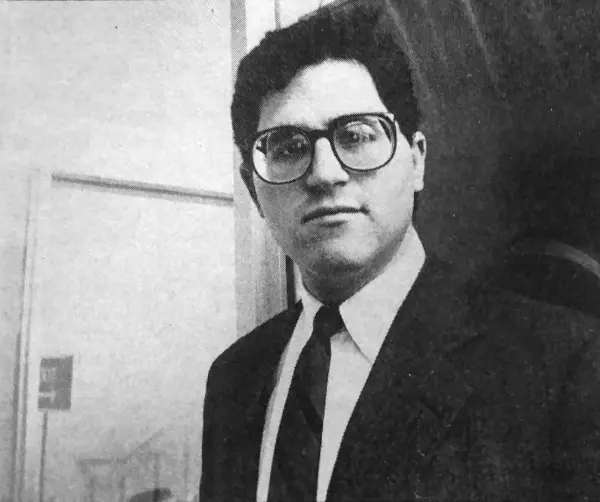
Michael Dell of, er, Dell, © Personal Computer World June 1988The pressure was really mounting by the late spring of '88 with word of imminent PS/2 clones from companies like Tandy, Dell and Kaypro.
Whilst many of these were clones of the Model 50, it was Tandy's threatened clone that was more of a surprise, as it was thought to be a full MCA-based Model 80 copy using Intel's MCA chip set.
Tandy's first official comment had come from its director of market planning Ed Juge, who said "it's no secret that we an lots of other firms are working on [PS/2], but I can't say when - next week, next month or next year".
This shocked IBM as it had thought it would take cloners at least two years to get to this point.
So it was inevitable that IBM had to open up and get pro-active rather than reactive.
Instead of fighting the clones, IBM would simply charge a 5% royalty on any MCA copy, whilst at the same time reducing its own prices, hoping that this would encourage buyers to go for genuine IBM machines.
However, Personal Computer World speculated that with the competition being fierce and with "IBM calling more of the pricing shots", it might actually discourage cloning activities, before concluding that the open licencing would mean that the PS/2 was "destined to be the next major standard in business and office computing"[2].
Despite that, it was noted that the original PC format (which came to be known as Industry Standard Architecture, or ISA) wasn't going anywhere fast, and that - according to Personal Computer World - "most market observers" reckoned that the original PC standard would be around for "at least another five years".
Part of the reason for this was in the adaptability of the original BIOS, which could be customised in all sorts of ways peculiar to individual manufacturers, but mostly it was the stark reality facing the MCA upstart: 15 million ISA-based IBM PCs and clones had already been sold by the spring of 1988[3], and that sheer weight of numbers was something that MCA ultimately couldn't shift.
The PS/2 band breaks up
In around March 1988, IBM held a major briefing about PS/2 for 30 industry consultants, including Personal Computer World's Tim Bajarin[4], at its Boca Raton, Florida, ESD headquarters.
This featured IBM's PC luminaries such as Bill Lowe, Mike Maples, Frank King and Bill Lyons, but by the time the second briefing rolled around in the early spring of 1989, this team had gone their separate ways, with Maples moving to Microsoft, King going to Lotus, Lyons to dBase software house Ashton-Tate and Lowe - the father of the (IBM) PC - moving to Xerox.
The outcome of this turmoil meant a change in the PS/2 administration, with Jim Cannavino taking over the reins.
However, unlike their predecessors, who were said to have been open and up-front about IBM's plans, the new leadership was being much more tight-lipped about Big Blue's plans for 1989, so much so that delegates left the conference feeling that they hadn't actually learned anything new.
One thing that did come out, however, was a change in IBM's relationship with NeXT, the company that Steve Jobs, formerly of Apple, had set up.
It had previously seemed like NeXT's NextStep operating system might be used as part of IBM's Unix strategy, however with Bill Lowe - who was the NeXT champion - gone, there was suddenly less of an allegiance to NextStep.
More significant though was that the Unix-focused Open Software Foundation - which IBM was a founding member of - now had the Motif X-Windowing system courtesy of SCO[5].
This was said to be so similar to Microsoft's Presentation Manager for OS/2 that it didn't really matter which of the two systems users were trained on - they were considered almost interchangeable - and so between them they very much looked like being a NextStep killer[6].
IBM and Microsoft split up
Lowe's disappearance from IBM to Xerox also marked a change in the relationship between IBM and Microsoft, as Bill Gates and Lowe had between them run the entire DOS software market, with the two companies very much in control.
However, Lowe's replacement at IBM - James Cannavino, appeared to be definitely not a Microsoft fan.
Signs of a split between the two had appeared towards the end of 1989, when there was a difference of opinion about how to implement PostScript fonts.
Cannavino had wanted to do the same thing as NeXT, which was to run a complete on-screen PostScript system, whilst Lowe and Gates were considering a new font system which had been developed with Apple.
Things came to a head at 1989's Comdex Fall, where Cannavino was "telling fibs" about what Windows couldn't do, whilst Gates was replying with a similar set of fibs about what OS/2 couldn't do.
An announcement from the two companies tried to patch things up by stating that they were not splitting up, which according to Guy Kewney writing in November 1990's Personal Computer World was clearly a sign that that was exactly what was happening. It was clear that the two companies were now on different paths, with Kewney pointing out that:
"Windows is good enough for 90% of DOS users, and OS/2 is not, nor will it be. IBM wants control of the DOS market and can't have it, and all the 'official statements' in the world can't change that fact".
Microsoft was selling Windows as a standard operating system into a large, general-purpose market, whilst IBM was shifting OS/2 into a small and specialist networking market. Kewney concluded:
"the two companies are heading away from each other ... it is all so blindingly obvious that there is a total split that I seriously wonder why they bother [denying it]"[7].
The dawn of 486
IBM had traditionally always boasted that "what you see is what you can get today".
However, back in the summer of 1989 it seemed to be getting fed up with Compaq always getting the credit for whatever the latest "new thing" was, plus it also wanted to reassure the increasing number of maufacturers who were by now producing MCA machines that there really was something better about the architecture.
Deciding to leap as far ahead of Compaq as it could, IBM announced a new 486 processor module at an event in New York which wasn't actually available yet, but would be soon - the company reckoned by the end of 1989, although Andy Redfern of Personal Computer World suggested that the first quarter of 1990 was more realistic.
The new machine wasn't actually a completely new 486 machine, but was instead an upgrade for one of IBM's existing higher-end PS/2 machines, the Model 70-A21, which was a relatively unusual micro in that all its CPU and cache RAM were already held on a daughter board.
This meant that IBM could swap this out with a new 486-based card and - bingo - it had a new machine, said to be between two and five time faster than a 386 PS/2, depending upon benchmark.
It wasn't especially cheap, coming in at £3,077, or around £10,300 in 2025 terms, and that was with a trade-in for the old card.
Personal Computer World wasn't sure what IBM planned to do with all the traded-in daughter boards, but thought it wouldn't be too much of an issue as only 10,000 A21's had been sold into Europe anyway[8].
---
Also in New York, at around the same time as IBM's pre-announcement, Intel - manufacturer of the CPU chips that IBM and most of the rest of the PC world relied on - was making a pre-announcement of its own.
However, it was going one better than IBM by pre-announcing what it thought would be its processor at the end of the 20th century: the Intel i786.
Intel's senior vice president David House continued "the i786 will be launched in the year 2000 and will be made up of over 100 million transistors".
The mock-up that House went on to demonstrate was not actually that far of the mark, housing four 32-bit CPU cores and with built-in graphics.
There was some concern as to how this would be achieved, as the problem of quantum tunnelling - where electrons started behaving oddly, acting like waves instead of particles and jumping across connections when the scale got too small - was already known, with Andy Redfern of Personal Computer World positing that this would limit CPU scales to around 0.4 microns, or 400 nanometers[9].
Intel's actual big release of 2000 was the Pentium 4, which had a transistor count of 42 million on a 0.18 micron process, but the prediction wasn't all that far out really - the February 2004 version of the Pentium 4 was already up to 125 million transistors at 90nm, or 0.09 microns[10].
As it happened, quantum tunnelling still doesn't seem to be causing problems, as Intel's arch rival AMD announced a chip built on a 7 nanometer process in July 2019 - that's some 60 times smaller than the projected limit in 1989[11]
Date created: 27 March 2024
Last updated: 11 December 2024
Hint: use left and right cursor keys to navigate between adverts.
Sources
Text and otherwise-uncredited photos © nosher.net 2025. Dollar/GBP conversions, where used, assume $1.50 to £1. "Now" prices are calculated dynamically using average RPI per year.
